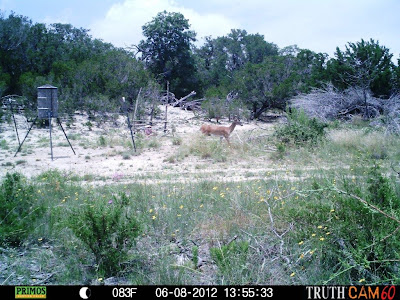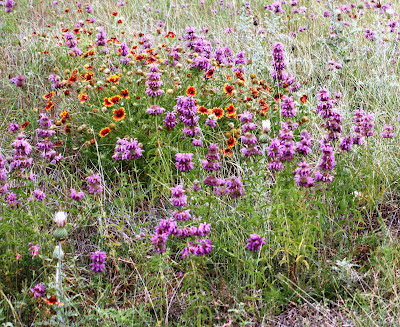Wednesday, June 27, 2012
Texas Mustang Grapes and Homemade Jelly
My wife and I checked on the wild Mustang grapes at our place in Lampasas this last week. We have been watching them this season in hopes of beating the coons and birds to enough ripe grapes to make some jelly or wine for the season. There were none last year due to the drought and very few this year. What few we saw will be ready over the next couple of weeks. If you have wild grape vines in your part of the country now is the time to check them as they will be ready very soon.
Mustang grape jelly always brings back memories of my grandmothers and my mom making jelly. The process would fill the house with a wonderful sweet, rich grape smell that promised the taste of biscuits filled with butter and the rich grape flavor of the Texas Hill County. It has been many years since I was involved with cooking the juice down from the grapes and I had forgotten how purple and rich the juice from wild mustang grapes becomes as you cook the grapes down. Here is a good basic recipe for a really pretty and wonderful tasting Mustang Grape jelly. Hope you enjoy the biscuits and peanut butter sandwiches that will taste a whole lot better with your homemade jelly.
Mustang Grape Jelly
Wash grapes thoroughly and put washed grapes in a cooker, add enough water to cover them. After the water starts to boil, cook the grapes (stirring frequently) until the skins begin to slip. When the skins will slip easily from the grapes, they are ready to press. Strain the cooked grapes and juice through a colander line with a jelly bag or medium textured cloth. Press all the juice from the grapes with a wooden spoon, but do not force the pulp through the colander. Add one box of fruit pectin to 5 cups of juice. Bring this mixture to a rolling boil and then add seven cups of sugar. Stirring constantly bring the mixture back to a rolling boil and cook for 3 to 5 minutes. When the mixture forms a string as it is poured from a spoon, remove from heat. Skim all the foam and crystals from the surface, and pour the processed jelly into hot sterilized jars. Seal immediately with canning lids before the jelly cools.
Warning: From personal experience let me warn you to wear latex or similar gloves to pick the grapes as the acid you will get on your hands burns. Also wear old clothes that you do not mind staining as the grapes stain everything they touch. Be very careful about getting the juice on anything you do not want to dye purple as the juice colors anything it is spilled on or wiped up with. Don’t ask me how I know. Wild Ed
Saturday, June 23, 2012
Caption Contest #22 Winner!

- Caution: objects seen in your camera are bigger than they appear.
- The winning caption was submitted by our clever Canadian friend Rondeau Ric.
Though I have to admit that the judging committee liked several others, including:
- Mark S. Garland: Even if the goalkeeper is down, I am not going to play a header.
- Wendy Eller: After Jack and his friends climbed the beanstalk, they decided to attend a soccer game.
- Richard: Let's see Chet Baker pop this one !!
- John W.: A dragonfly with an all-yellow head ...and very close-set eyes. Nope, not in this field guide.
- Erik: Anyone else's cell phone getting 5,000,000,000,000 bars?
and...
- Murr Brewster: Sorry. I'm not touching this caption with a ten-inch pole.
Thursday, June 21, 2012
Our Two Nests!
Here at Bird Watcher's Digest we're intently watching two different—vastly different—birds' nests. One of them has growing nestlings approaching their fledging date. The other nest is still being built.
Our soon-to-fledge nest is a red-shouldered hawk effort, complete with three age-disparate nestlings. Here's a short video clip to show how this nest looks today (Thursday, June 21).
And here is a longer clip of the second nest, which a ruby-throated hummingbird female is busy building right outside my office window at BWD.
Both of these clips were taken with my iPhone 4s camera using a Macguyver'd iPhone camera adapter and my spotting scope.
It's really nice to be able to watch this all unfolding from my workplace. A distraction that makes working inside a tad more enjoyable.
Our soon-to-fledge nest is a red-shouldered hawk effort, complete with three age-disparate nestlings. Here's a short video clip to show how this nest looks today (Thursday, June 21).
And here is a longer clip of the second nest, which a ruby-throated hummingbird female is busy building right outside my office window at BWD.
Both of these clips were taken with my iPhone 4s camera using a Macguyver'd iPhone camera adapter and my spotting scope.
It's really nice to be able to watch this all unfolding from my workplace. A distraction that makes working inside a tad more enjoyable.
Sunday, June 17, 2012
Summer Visitors to the Game Feeder
My brother sent me some pictures from a game camera at one of the feeders he has going up at his place in Lampasas. It has been very hot as of late, but he still has a few visitors looking for a handout. I thought you might enjoy seeing his pictures, Wild Ed
Click on the pictures to get a larger view
Thursday, June 14, 2012
JUSTIFIED
This week I am doing something different and letting you in on my favorite TV show for the last two seasons, Justified. The story follows a US Marshall and his return to where he grew up in Harlan, Kentucky. There is some terrible music on the series along with some greats such as the song in the following video. If you have not seen this show it is worth the time. I have not missed a show, Wild Ed
The next two videos highlight some of the confrontations in the life of Raylan the Marshall.
The Whole Song
Half-cap the Goldfinch
 Look closely at this bird. Notice anything missing? This is a male American goldfinch in summer/breeding plumage. Bright yellow body, black wings and tail...
Look closely at this bird. Notice anything missing? This is a male American goldfinch in summer/breeding plumage. Bright yellow body, black wings and tail...Here's a photo of a different male American goldfinch. Notice the prominent black cap? Now look again at the male above. And, when you're ready, scroll down to the third image in this post.

 This is the male American goldfinch we call Half-cap. He's been around our farm for more than a year. We're not sure why he has just half a black cap. Was it some genetic abnormality? Is he half female? Was he injured on his head at some point in his life?
This is the male American goldfinch we call Half-cap. He's been around our farm for more than a year. We're not sure why he has just half a black cap. Was it some genetic abnormality? Is he half female? Was he injured on his head at some point in his life? Whatever the reason, he seems to be otherwise normal and enjoys all the things goldfinches do—sing, chatter, visit the feeders, fly around the valley in noisy, undulating flocks.
Whatever the reason, he seems to be otherwise normal and enjoys all the things goldfinches do—sing, chatter, visit the feeders, fly around the valley in noisy, undulating flocks.It's always nice to see him. He's another one of our marker birds—birds with a telltale physical feature that makes them easy to spot as individuals. We've had Mr. Troyer, the male eastern bluebird with a droopy wing from a sharp-shinned hawk attack; Snowflake the leucistic dark-eyed junco, and a few others.
I'm hoping Half-cap enjoys a long, fruitful life here on our farm.
Wednesday, June 13, 2012
Saturday, June 9, 2012
Lampasas Texas Wildflowers
My wife and I went up to the place this week to work and by the time we arrived it was raining. Rain is always welcome so we spent the day working in the barn on inside projects. It stopped raining for a little while after we ate lunch so we decided to take the dog and go check out the water troughs and feeders. I took some shots of all the many beautiful wildflowers and thought you guys might enjoy them. I also included a few game camera shots for your pleasure. Get out and enjoy the flowers before they are gone for this year. Wild Ed
Thursday, June 7, 2012
Some North Dakota Birds (& Pie)
 If you've never been to North Dakota on a birding trip this post will give you a taste of just some of the birds we see. Things like Virginia rail (above) and sharp-tailed grouse (below).
If you've never been to North Dakota on a birding trip this post will give you a taste of just some of the birds we see. Things like Virginia rail (above) and sharp-tailed grouse (below).
 Male yellow-headed blackbirds sing their retching songs from every slough.
Male yellow-headed blackbirds sing their retching songs from every slough. And drake blue-winged teal forage and float on flooded fields.
And drake blue-winged teal forage and float on flooded fields. Marsh wrens send their chatter-scolds across the cattails, the sound often swept away by the swift prairie wind.
Marsh wrens send their chatter-scolds across the cattails, the sound often swept away by the swift prairie wind. A shelter belt near an old farmstead might be the home of a pair of nesting Say's phoebes.
A shelter belt near an old farmstead might be the home of a pair of nesting Say's phoebes. And American bitterns are fairly easy to see among the potholes in the coteau.
And American bitterns are fairly easy to see among the potholes in the coteau.
Some days are gray, chilly, and wet—but that never stops us. In fact the challenging weather makes it all the more sweet when you stop for lunch at one of the small ton cafes, like the great one in Woodworth.
 Where they make amazing pies for their hungry customers.
Where they make amazing pies for their hungry customers. Rhubarb pie is my favorite. I can already taste it!
Rhubarb pie is my favorite. I can already taste it!For more information about birding in North Dakota and the Potholes & Prairie Birding Festival, visit birdingdrives.com
Subscribe to:
Comments (Atom)



































